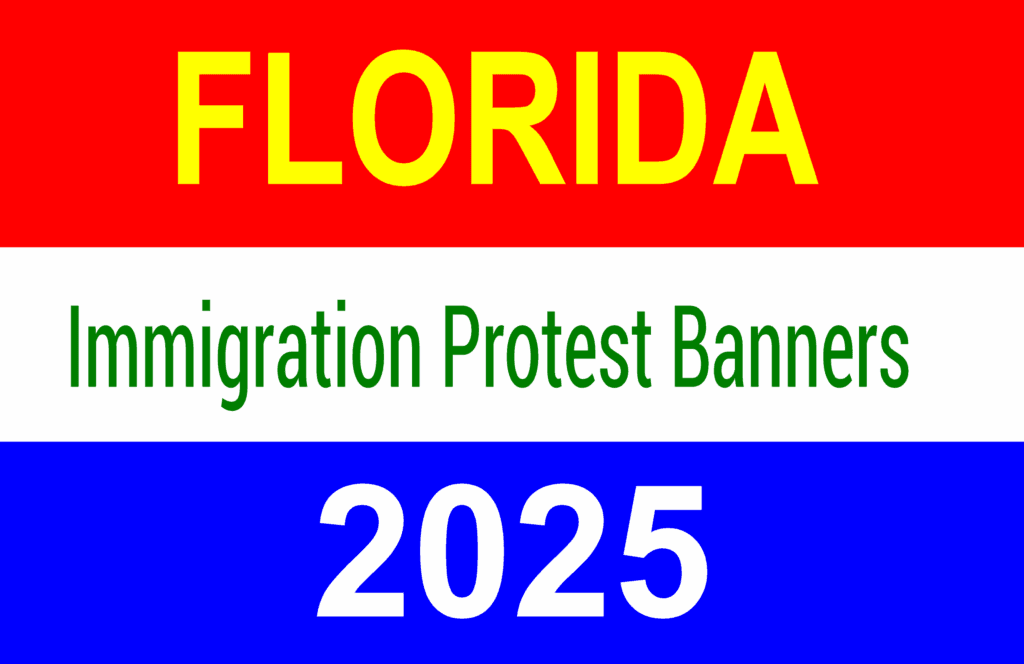Florida immigration banners are sending a powerful message of solidarity. Across Florida, cities are alive with protests calling for immigration justice. Protesters march through Miami, Tampa, and Orlando. They carry signs and banners that demand change. These visuals are bold, emotional, and impossible to ignore. So, they help turn small rallies into large movements.
In downtown Miami, a 20-foot banner stretched across the street read “No More Deportations.” It stopped traffic and sparked conversations. Protesters held it at a courthouse where families were fighting deportation orders. But the banner wasn’t just a backdrop—it was a bold statement seen by thousands.
Orlando saw a different approach. Protesters used vertical banners on poles that said “Reunite Families Now.” Marchers carried them while chanting in English and Spanish. So, even those watching from sidewalks or offices saw the message loud and clear.
In Tampa, activists hung vinyl banners from overpasses before a large rally. They read “Abolish ICE” and “Protect Our Neighbors.” These immigration banners stayed up for hours. Drivers took photos and posted them online. So, the protest reached far beyond the streets.
Florida Immigration Banners Designs That Demand Attention
Florida protests don’t just use words—they use bold visuals. The designs on banners are planned with care and meaning. So, colors like red, black, and yellow grab the eye. Protesters use thick block letters for easy reading. But they also add emotional artwork and cultural symbols.
In Fort Lauderdale, one protest featured a cloth banner showing a broken chain between a mother and child. The words “End Family Separation” appeared below. That single banner made many stop and cry. So, the art did more than the chant.
St. Petersburg students joined a protest with hand-painted banners reading “Dreamers Belong Here.” They used bright pastels and stars to represent hope. But they also added the names of DACA recipients on the edges. Each name made the message personal.
In Jacksonville, artists joined the protest movement with massive canvas murals. One banner displayed the Statue of Liberty holding a crying child. Below it were the words, “We Are All Worthy.” So, art and activism blended in a powerful way.
How Banners Amplify the Protest Voice
Protesters use banners to be louder without shouting. These visuals give power to silent stories. So, even those who fear speaking out can hold up a message.
In Immokalee, farmworkers marched through fields with fabric banners tied between two wooden poles. The banners read “We Feed America—Respect Us.” Photos of this rural protest reached thousands online. So, even small-town rallies gained national reach through visual impact.
Protest signs and banners in Florida often include multiple languages. In Hialeah, a Cuban-American neighborhood, banners displayed slogans in both Spanish and English. One read “Libertad Para Todos / Freedom for All.” But another one read simply, “Aquí Estamos y No Nos Vamos” (“We’re here and not leaving”). So, culture and language became part of the protest identity.
During a protest outside the ICE facility in Broward County, protesters held glowing LED banners at night. They spelled out “Stop the Raids.” These lights cut through darkness and were visible blocks away. So, even late-night rallies carried a bright message.
Florida Cities Leading With Powerful Visuals
Florida’s diverse cities give each protest a unique look and feel. But one thing connects them—banners are always central. They guide crowds, define causes, and make people pay attention.
In Orlando, march organizers used five identical vinyl banners to lead marchers down Colonial Drive. They read “One Florida, United by Justice.” Each banner matched the next, giving the event a strong, organized look. So, the visuals matched the seriousness of the cause.
Miami’s Little Haiti district saw bilingual banners during a protest supporting Haitian refugees. One banner had the Haitian flag beside the message “Human Rights Have No Border.” But another sign read “Deportations Kill Families.” So, messages were both global and personal.
In Gainesville, local schools supported immigrant students with student-made protest banners. Teens created posters reading “Education Not Deportation.” They tied their banners to fences around the campus. So, even those who couldn’t join a march showed their support.
Across Florida, protest banners are more than accessories. They’re vital tools that give weight to every step and chant. So, they help shape public opinion, media coverage, and even local policy discussions.
Conclusion
Florida’s immigration protests are filled with voices demanding justice—and signs and banners carry those voices far. These banners do more than inform. They inspire, connect, and push action. So, each banner becomes a megaphone for change.
From overpasses to courthouses, from rural fields to college campuses, banners show up strong. They speak when voices crack. They hold space for stories untold. And they remind the public that this movement is here to stay.
So, expect to see more signs and banners across Florida. As long as immigrants face fear and injustice, these visual messages will keep waving high above the crowds.
Please protest peacefully your anti-ICE messages, Anti-Immigration message and other social causes.

